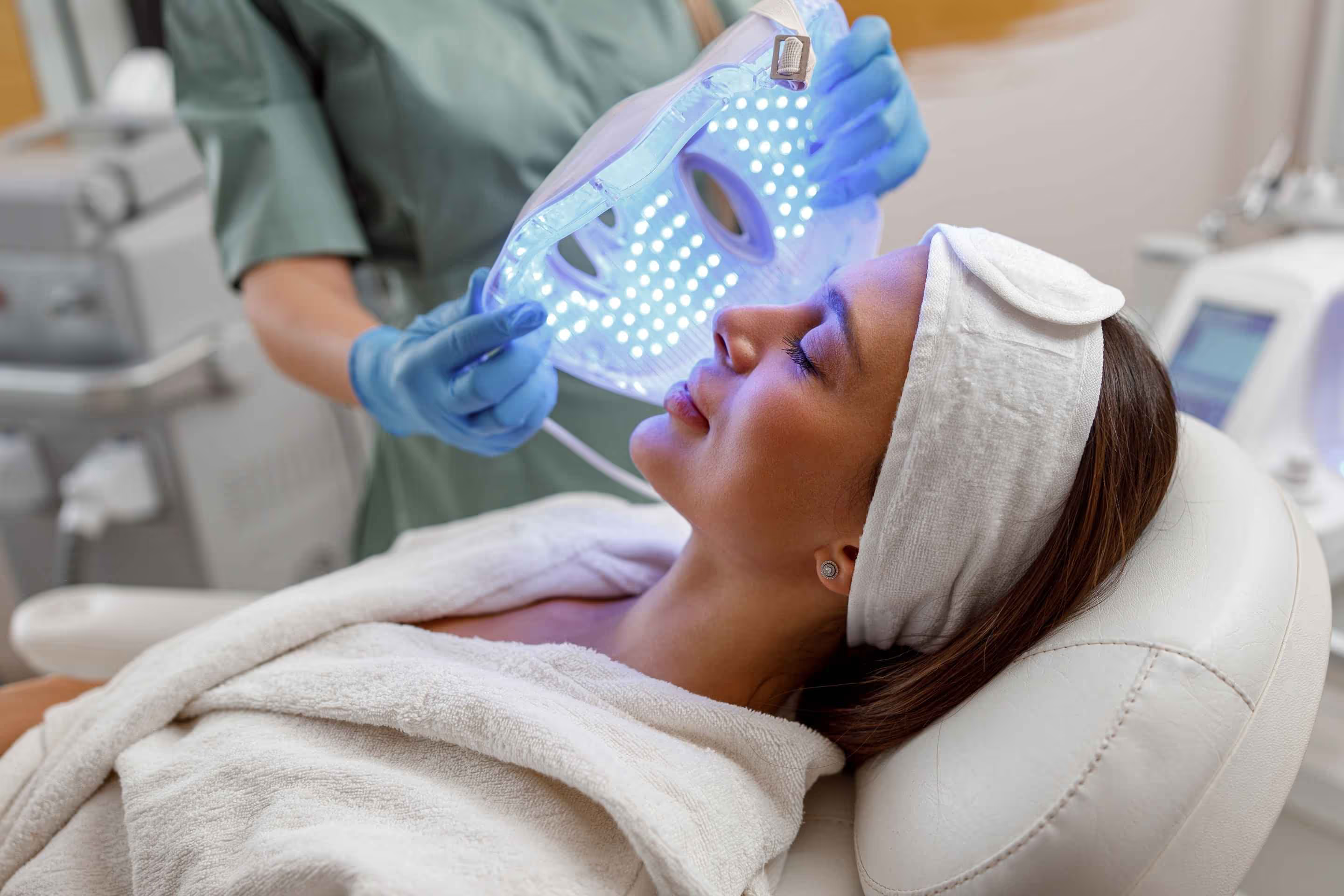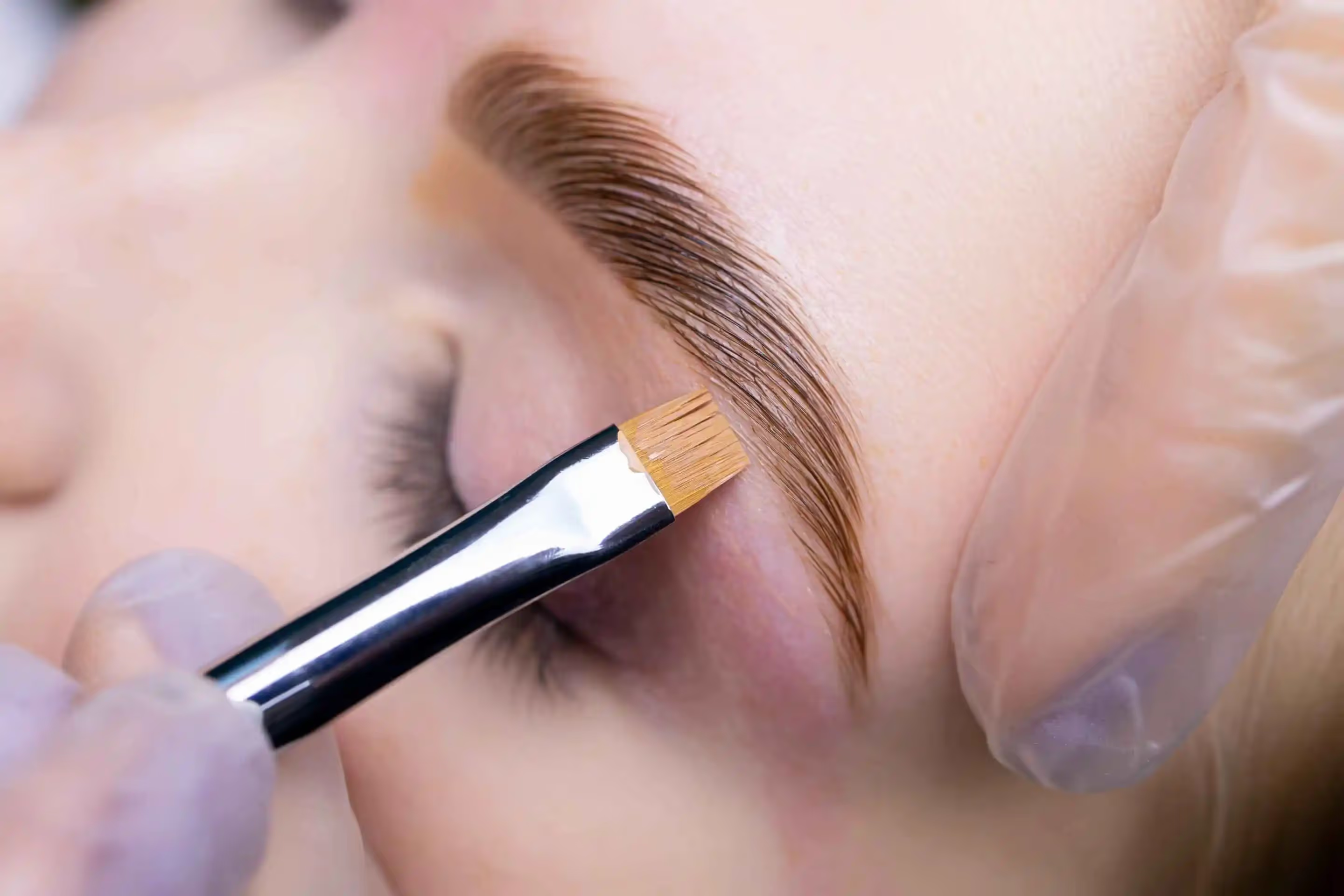What is light therapy?
LED light therapy is based on the use of light waves of different lengths that penetrate the skin and affect the biological processes occurring in it. Depending on the color of the light — and thus the wavelength — other effects are achieved. The technologies used do not violate the continuity of the epidermis, and the emitted light does not cause tissue heating or cell damage. Each color corresponds to specific indications and acts on a different level of the skin.
Red light
Red light operates in the wavelength range of about 620 to 750 nm and penetrates into the deeper layers of the dermis. This type of irradiation stimulates fibroblasts to produce collagen, which promotes densification of the skin and improvement of its elasticity. As a result, it can lead to a reduction in wrinkles and an improvement in skin tone. It is often used in anti-aging treatments, it also supports the healing process of minor damage and regeneration after other cosmetic procedures.
Blue light
Blue light exhibits antibacterial and anti-inflammatory effects. Waves with a length of about 415—495 nm do not penetrate deeply, but effectively affect the epidermal layer. In contact with the porphyrins produced by the bacteria Propionibacterium acnes, reactive oxygen forms are generated that destroy these microorganisms. This is why blue light is used to reduce acne, especially in its active inflammatory phase. It also supports the reduction of inflammation within the skin.
Green light
Green light acts superficially, penetrating to a depth of about 500—550 nm. Affects the equalization of skin tone and can reduce pigmentation. It is also used to lighten the skin and reduce the appearance of redness or pigmentation spots. It helps to stabilize the process of melanogenesis, which makes it useful in the therapy of skin with uneven tone.
Yellow light
Yellow light shows soothing properties and supports microcirculation. Waves with a length of about 570—590 nm improve blood circulation, which can accelerate the nutrition of skin cells and support the healing process. Yellow light is used in the care of sensitive and vascular skin, it also reduces the feeling of irritation after other aesthetic treatments.
Infrared Light
Although invisible to the naked eye, infrared light has the deepest range of all LED colors. It reaches all the way to the subcutaneous layer and affects the metabolism of cells. Improves blood circulation and supports regenerative processes. It is used in the therapy of muscle pain, relieving tension and accelerating tissue regeneration after injuries. In cosmetology, it supports the regeneration of the skin and improves its structure.
How is light therapy at home different from salon treatment?
LED light therapy at home usually involves small tools, such as an LED mask or hand-held lamps with limited power. They are designed for easy operation and everyday use. In cosmetology salons, on the other hand, professional equipment with a higher light intensity and a larger area of action is used, which allows deeper penetration of the skin and a more intense action. The procedure performed by the cosmetologist also takes into account the individual assessment of the skin condition and the adjustment of the parameters to the needs of the patient, which often translates into faster results.
Indications for LED therapy
Light therapy is used by people with various skin problems and ailments. The use of this method includes, but is not limited to:
- signs of aging, including the appearance of wrinkles and loss of firmness;
- acne lesions and symptoms of psoriasis and herpes;
- stretch marks, cellulite and other disorders of the structure of the skin;
- alopecia and excessive hair loss;
- lymphatic edema and reduction of inflammation;
- burns of I and II degree;
- complaints of pain in muscles and joints.
LEDs support the healing process and can accelerate tissue regeneration. The variety of light wavelengths allows the method to be precisely tailored to the specific problem.
LED light therapy — contraindications
Although LED light therapy (both at home and in the salon) is considered safe, there are cases in which its use may not be advisable. Among other things, this applies to:
- pregnancy;
- diagnosed skin cancer at the site of the planned procedure;
- taking medications that are photodegradable;
- Epilepsy;
- photosensitivity.
Before starting home therapy, it is worth consulting with a dermatologist, especially if you have doubts about your health condition.
Is LED light therapy at home safe?
Procedures carried out in house conditions, while observing the manufacturer's recommendations, are considered safe. Modern devices are designed in a way that minimizes the risk of burns or skin overloads. However, it should be borne in mind that the effectiveness of treatments may be limited compared to sessions carried out in a professional salon of aesthetic cosmetology. Lower light intensity and simplified customization options mean that effects can appear more slowly and be less noticeable.
When is it better to choose LED treatment in the salon?
The decision to resort to professional treatment may be justified in several specific cases. We present situations in which a visit to the salon will be a better choice.
With more serious skin problems
Deep acne scars, aggravated acne lesions or pronounced flabbiness of the skin require a stronger action than that offered by homemade LED lamps. Cabinet devices have more power and are able to act more effectively on the deeper layers of the skin.
When professional diagnostics and personalization of the procedure are needed
The specialist can conduct a thorough interview, determine the type of skin, its needs and select the parameters of irradiation. This is especially true for problems that require an individualized approach. Therapy tailored to a particular patient increases the chance of noticeable effects.
Benefits of using medical equipment with higher power
Professional devices not only have higher technical characteristics, but are often equipped with additional functions. For example, they emit blue and red LED light at the same time, which allows a comprehensive effect - from acne reduction to wrinkle reduction. Equipment of this class also guarantees better wavelength stability, which affects uniform operation.
How does the procedure look like in the office?
Treatment begins with a consultation, during which the cosmetologist assesses the condition of the skin and collects the necessary health information. Based on this, he draws up an individual LED therapy plan, taking into account both indications and potential contraindications.
The next stage is the preparation of the skin - thorough cleansing and preparation for exposure to light. The patient is laid under a device that emits red, blue or mixed light. The session usually lasts 20-30 minutes. Once finished, the skin is protected with a suitable cosmetic to support skin regeneration.
The procedure is completely painless and does not require a break in daily duties. Patients often feel a sense of relaxation, and many of them notice improvement after just a few sessions. For full therapy, it is recommended to perform a series of procedures that allow to achieve lasting effects in the form of a pronounced smoothing of the skin and reducing the appearance of wrinkles.
What effects does light therapy bring and when to expect them?
The results of LED light therapy depend on the type of light used, the regularity of the procedures and the individual characteristics of the skin. The first effects, such as improving the tone or relieving irritation, can be noticeable after just a few sessions. In the case of long-term measures — such as skin regeneration, wrinkle reduction or elasticity improvement — visible changes usually appear after a series of about 6—10 treatments performed at intervals of several days.
When using red or infrared light, a gradual smoothing of the skin structure, a decrease in fine furrows and an improvement in firmness are observed. In people who use blue light, the effects in the form of reduction of acne lesions appear faster, especially with active inflammations. LED Light Therapy works gently, therefore the changes occur gradually — without sudden skin reactions and without the need for recovery.
The effectiveness of treatments increases with the simultaneous use of proper home care and avoiding factors that can weaken the effect of light, such as excessive sun exposure, smoking or irregular skin cleansing. The final effect is fixed after the completion of a full series of treatments and may persist for several weeks or months.
FAQ:
- Does LED light therapy hurt?
No, LED light therapy is painless and does not cause discomfort. During the procedure, there is no overheating of the skin or violation of its surface. Most people describe the exposure as pleasant and relaxing, without any discomfort during or after the session. - Is it possible to use an LED mask every day?
It is not recommended to use the LED mask daily. The optimal frequency is 2—4 times a week, depending on the type of skin and the manufacturer's recommendations. Too frequent use can lead to overdrying or temporary irritation, especially with sensitive skin. - Are the effects of home therapy permanent?
The effects appear gradually and last for several weeks after the end of a series of treatments. However, for the results to be long-lasting, regularity is necessary. It is recommended to repeat the cycle every few months and supplement it with proper skin care.








